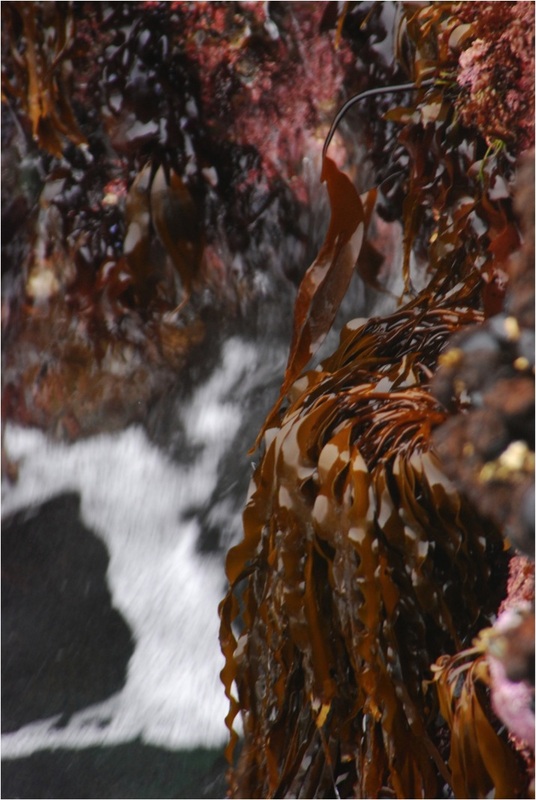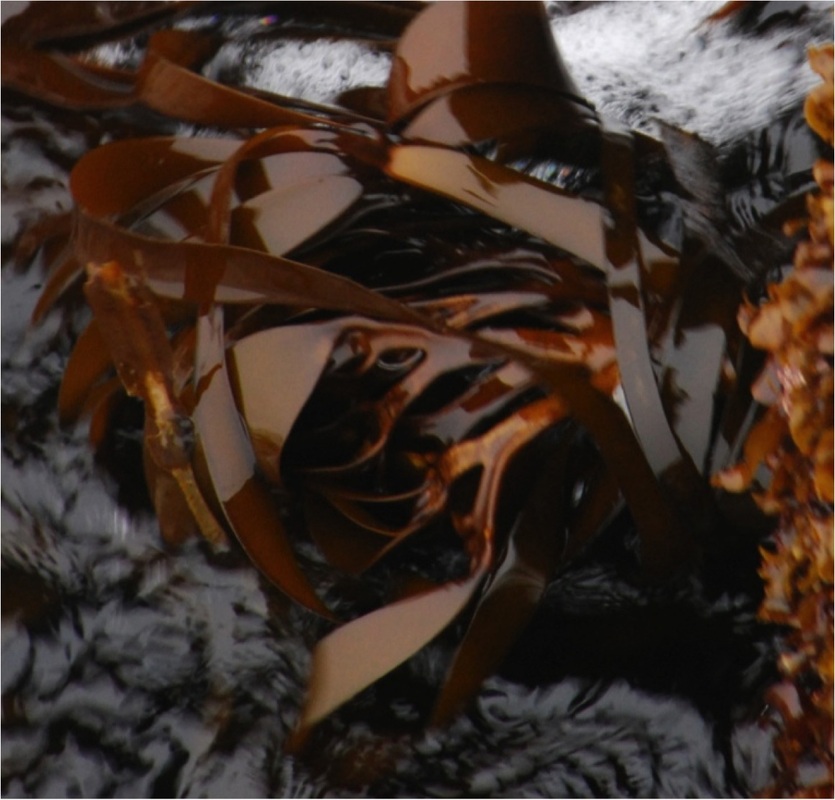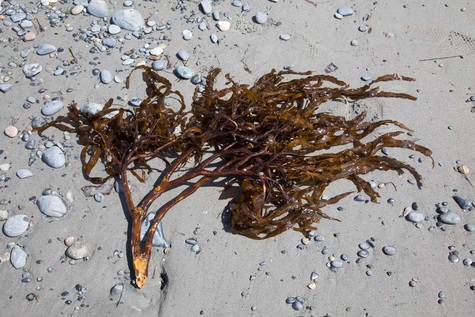Flat pompom kelp, strap kelp • Lessoniopsis littoralis
|
Right: this species has a stiff, trunk-like branching stipe. Photo by Wiebe Nijland. Top left: long, thin, strap-like blades that cluster are a key ID feature of flat pompom kelp. Bottom left: the stipe branches dichotomously many times, with each terminal branch leading to a blade - this branching is also indicative of this species. Photos by Joel White.
|
Identification
Flat pompom kelp is a medium to dark brown kelp and is characterized by a stiff, trunk-like stipe with multiple dichotomous branches that lead to clustered, strap-like blades (see photo of branching pattern). Each blade has a midrib and can be up to 1 m long. Flat pompom kelp has large, conical holdfast that is composed of many branched haptera and can reach 15 cm across. A single individual can have up to 500 blades, each arising from its own stipe branch. Sporophylls grow near the base of older blades; they lack midribs, and are shorter and wider than the sterile blades.
Habitat & Range
Flat pompom kelp is found in the very low intertidal and shallow subtidal of exposed rocky habitats. It usually exists in a narrow zone below sea cabbage (Saccharina sessilis) but above southern stiff-stiped kelp (Laminaria setchelli). Its range extends from Kodiak Island, Alaska to Monterey County, California.
Similar Species
Northern rhizome kelp (Laminaria longipes) has similarly clustered strap-like blades, but has a rhizomatous holdfast rather than a conical hapteroid holdfast.
Flat pompom kelp is a medium to dark brown kelp and is characterized by a stiff, trunk-like stipe with multiple dichotomous branches that lead to clustered, strap-like blades (see photo of branching pattern). Each blade has a midrib and can be up to 1 m long. Flat pompom kelp has large, conical holdfast that is composed of many branched haptera and can reach 15 cm across. A single individual can have up to 500 blades, each arising from its own stipe branch. Sporophylls grow near the base of older blades; they lack midribs, and are shorter and wider than the sterile blades.
Habitat & Range
Flat pompom kelp is found in the very low intertidal and shallow subtidal of exposed rocky habitats. It usually exists in a narrow zone below sea cabbage (Saccharina sessilis) but above southern stiff-stiped kelp (Laminaria setchelli). Its range extends from Kodiak Island, Alaska to Monterey County, California.
Similar Species
Northern rhizome kelp (Laminaria longipes) has similarly clustered strap-like blades, but has a rhizomatous holdfast rather than a conical hapteroid holdfast.
References
Lindberg, M. and Lindstrom, S. (2010). Lessoniopsis littoralis. Seaweeds of Alaska. Accessed 05/08/2014.
O'Clair, R. and Lindstrom, S. Lessoniopsis littoralis (Tilden) Reinke 1903. In Klinkenberg, Brian. (Ed.). E-Flora BC: Electronic Atlas of the Plants of British Columbia. Lab for Advanced Spatial Analysis, Department of Geography, University of British Columbia, Vancouver. Accessed 05/08/2014.
Authors and editors of page
Joel White, Kelly Fretwell, and Brian Starzomski (2014).
Lindberg, M. and Lindstrom, S. (2010). Lessoniopsis littoralis. Seaweeds of Alaska. Accessed 05/08/2014.
O'Clair, R. and Lindstrom, S. Lessoniopsis littoralis (Tilden) Reinke 1903. In Klinkenberg, Brian. (Ed.). E-Flora BC: Electronic Atlas of the Plants of British Columbia. Lab for Advanced Spatial Analysis, Department of Geography, University of British Columbia, Vancouver. Accessed 05/08/2014.
Authors and editors of page
Joel White, Kelly Fretwell, and Brian Starzomski (2014).






